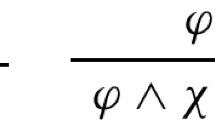Abstract
This paper has two goals. First, I argue that contrary to what has been assumed by many previous works, the two characteristics of long-distance reflexivization, long-distance binding and subject-binding, should not be treated as two inseparable consequences of a single LF operation. While long-distance binding indeed results from LF movement, subject-binding must be analyzed separately. Secondly, I show that it is not necessary to make the unjustified assumption that bare reflexives always involve X0-movement while compound reflexives move only as phrases. Given Huang's observation that there is no Subjacency effect at LF, the contrast between long-distance binding and local binding can be accounted for by uniformly moving N0 (=head of a reflexive) at LF regardless of the actual form of the reflexive. The only constraints are the independently motivated ones such as Lasnick and Saito's ECP and Li's theory of X0-binding.
Similar content being viewed by others
References
Abney, Steven (1987)The English Noun Phrase in Its Sentential Aspects, PhD dissertation, MIT Press, Cambridge.
Aoun, Joseph (1986)Generalized Binding, Foris, Dordrecht.
Aoun, Joseph, Norbert Hornstein, David Lightfoot, and Amy Weinberg (1987) “Two Types of Locality,”Linguistic Inquiry 18, 537–577.
Baker, Mark (1988)Incorporation: A Theory of Grammatical Function Changing, University of Chicago Press, Chicago.
Baker, Mark, Kyle Johnson, and Ian Roberts (1989) “Passive Arguments Raised,”Linguistic Inquiry 20, 219–251.
Battistella, Edwin (1987) “Chinese Reflexivization,” ms., University of Alabama at Birmingham.
Bresnan, Joan (1982) “The Passives in Lexical Theory,” in J. Bresnan (ed.),Mental Representation of Grammatical Relations, MIT Press, Cambridge, pp. 000–000.
Chomsky, Noam (1972)Studies on Semantics in Generative Grammar, Mouton, The Hague.
Chomsky, Noam (1981)Lectures on Government and Binding, Foris, Dordrecht.
Chomsky, Noam (1986a),Knowledge of Language: Its Nature, Origin, and Use, Praeger, New York.
Chomsky, Noam (1986b)Barriers, MIT Press, Cambridge
Chomsky, Noam (1991) “Some Notes on Economy of Derivation and Representation,” in Robert Freidin (ed.),Principles and Parameters in Comparative Grammar, MIT Press, Cambridge, pp. 417–454.
Cinque, Guglielmo (1990)Types of A′-Dependencies, MIT Press, Cambridge.
Cole, Peter, Gabriella Hermon, and Li-May Sung (1990) “Principles and Parameters of Long-distance Reflexives,”Linguistic Inquiry 21, 1–22.
Di Sciullo, Anna Maria, and Edwin Williams (1987)On the Definition of Words, MIT Press, Cambridge.
Fukui, Naoki and Margaret Speas (1986) “Specifiers and Projections,”MIT Working Papers in Linguistics 8, 128–172.
Grimshaw, Jane (1982) “On the Lexical Representation of Romance Reflexives,” in Joan Bresnan (ed.),Mental Representation of Grammatical Relations MIT Press, Cambridge, pp. 000–000.
Hellan, Lars (1988)Anaphora in Norwegian and the Theory of Grammar, Foris, Dordrecht.
Higginbotham, James (1987) “Elucidations of Meaning,”MIT Lexicon Project Working Papers 19.
Huang, James (1982)Logical Relations in Chinese and the Theory of Grammar, PhD dissertation, MIT.
Huang, James and Jane Tang (1988) “The Local Nature of the Long-Distance Reflexives in Chinese,”Proceedings of NELS 18, pp. 191–206.
Katada, Fusa (1991) “The LF Representation of Anaphors,”Linguistic Inquiry 22, 287–313.
Kayne, Richard (1989) “Null Subjects and Clitic Climbing,” in Osvaldo Jaeggli and Kenneth Safir (eds.),The Null Subject Parameter, Kluwer, Dordrecht, pp. 239–262.
Koopman, Hilda (1984)The Syntax of Verbs: From Verb Movement Rules in the Kru Languages to Universal Grammar, Foris, Dordrecht.
Lasnik, Howard and Mamoru Saito (1984) “On the Nature of Proper Government,”Linguistic Inquiry 15, 235–289.
Lebeaux, David (1983) “A Distributional Difference between Reciprocals and Reflexives,”Linguistic Inquiry 14, 723–730.
Li, Yafei (1990a) “X0-binding and Verb Incorporation,”Linguistic Inquiry 21, 399–426.
Li, Yafei (1990b)Conditions on X 0-Movement, PhD dissertation, MIT.
Li, Yafei (1992) “Why Doesn't X-trace Seem to Need Formal Licensing?” paper presented at the 14th GLOW, Lisbon.
Lieber, Rochelle (1983) “Argument Linking and Compounds in English,”Linguistic Inquiry 14, 251–285.
Maling, Joan (1983) “Non-clause Bound Reflexives in Modern Icelandic,”Linguistics and Philosophy 7, 211–241.
Manzini, Maria Rita and Kenneth Wexler (1987) “Parameters, Binding Theory, and Learnability,”Linguistic Inquiry 18, 413–444.
May, Robert (1985)Logical Form, MIT Press, Cambridge.
Pesetsky, David (1985) “Morphology and Logical Form,”Linguistic Inquiry 16, 193–246.
Pica, Pierre (1986) “On the Nature of the Reflexivization Cycle,” ms., Pennsylvania State University.
Reinhart, Tanya (1983)Anaphora and Semantic Interpretation, Croom Helm, London.
Rizzi, Luigi (1986) “On Chain Formation,” in Hagit Borer (ed.),Syntax and Semantics 19:The Syntax of Pronominal Clitics, Academic Press, New York.
Rizzi, Luigi (1990)Relativized Minimality, MIT Press, Cambridge.
Roberts, Ian (1991) “Excorporation and Minimality,”Linguistic Inquiry 22, 209–218.
Sells, Peter (1987) “Aspects of Logophoricity,”Linguistic Inquiry 18, 445–479.
Sportiche, Dominique (1990), “Movement, Agreement, and Case,” ms., UCLA.
Thráinsson, Höskldur (1979)On Complementation in Icelandic, Garland, New York.
Travis, Lisa (1984)Parameters and Effects of Word Order Variation, PhD dissertation, MIT.
Author information
Authors and Affiliations
Additional information
I thank Jim Huang and Howard Lasnik for thoroughly discussing this paper with me. I also discussed various parts of this paper with Duanmu San, Jane Grimshaw, Ken Hale, Joan Maling, Wayne O'Neil, and Esther Torrego. TwoJEAL reviewers' comments have helped make my arguments more rigorous. I thank them for sharing their expertise with me. I am grateful to Duanmu San, Wang Yüyan, and Xie Qing for providing their judgments on the Chinese data.
Rights and permissions
About this article
Cite this article
Li, Y. What makes long distance reflexives possible?. J East Asian Linguis 2, 135–166 (1993). https://doi.org/10.1007/BF01732502
Received:
Revised:
Issue Date:
DOI: https://doi.org/10.1007/BF01732502




